IPO of USA: Process, Advantages, and Challenges
VerifiedAdded on 2022/11/16
|10
|2438
|400
AI Summary
This article covers the process, advantages, and challenges of Initial Public Offering (IPO) in the USA. It also discusses the comparison of working conditions in China and the USA, and strategies for expatriates. Additionally, it includes a sick leave policy.
Contribute Materials
Your contribution can guide someone’s learning journey. Share your
documents today.
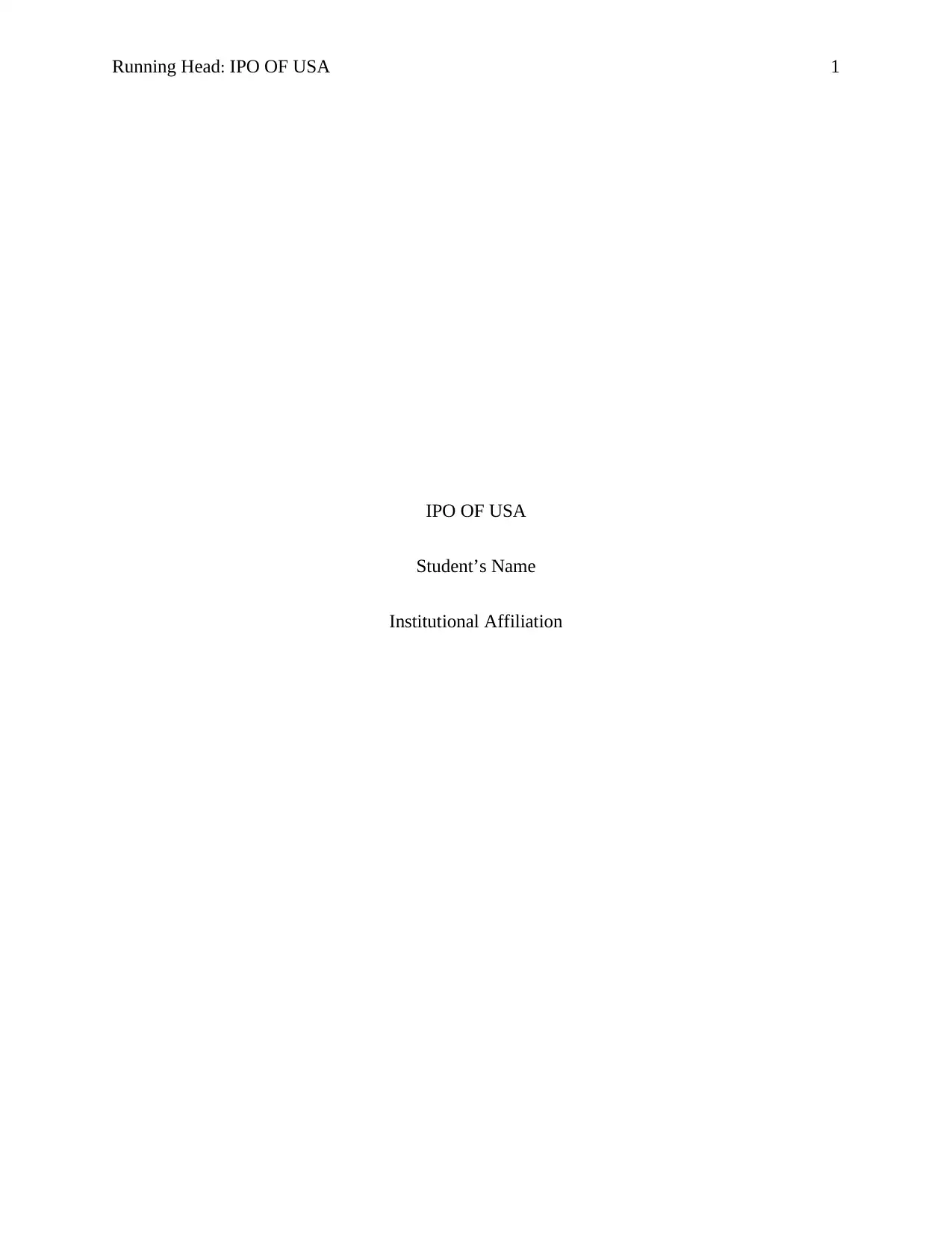
Running Head: IPO OF USA 1
IPO OF USA
Student’s Name
Institutional Affiliation
IPO OF USA
Student’s Name
Institutional Affiliation
Secure Best Marks with AI Grader
Need help grading? Try our AI Grader for instant feedback on your assignments.
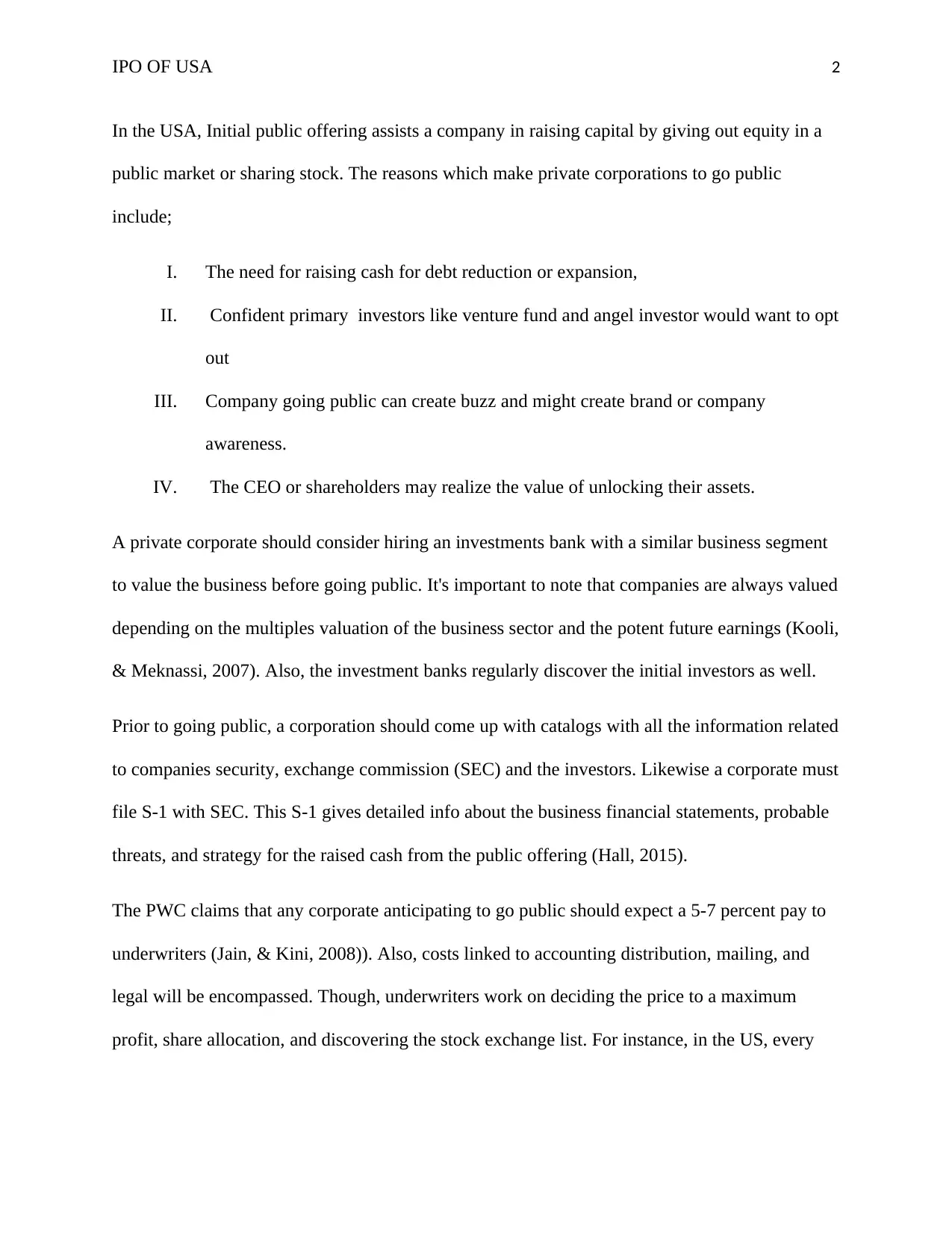
IPO OF USA 2
In the USA, Initial public offering assists a company in raising capital by giving out equity in a
public market or sharing stock. The reasons which make private corporations to go public
include;
I. The need for raising cash for debt reduction or expansion,
II. Confident primary investors like venture fund and angel investor would want to opt
out
III. Company going public can create buzz and might create brand or company
awareness.
IV. The CEO or shareholders may realize the value of unlocking their assets.
A private corporate should consider hiring an investments bank with a similar business segment
to value the business before going public. It's important to note that companies are always valued
depending on the multiples valuation of the business sector and the potent future earnings (Kooli,
& Meknassi, 2007). Also, the investment banks regularly discover the initial investors as well.
Prior to going public, a corporation should come up with catalogs with all the information related
to companies security, exchange commission (SEC) and the investors. Likewise a corporate must
file S-1 with SEC. This S-1 gives detailed info about the business financial statements, probable
threats, and strategy for the raised cash from the public offering (Hall, 2015).
The PWC claims that any corporate anticipating to go public should expect a 5-7 percent pay to
underwriters (Jain, & Kini, 2008)). Also, costs linked to accounting distribution, mailing, and
legal will be encompassed. Though, underwriters work on deciding the price to a maximum
profit, share allocation, and discovering the stock exchange list. For instance, in the US, every
In the USA, Initial public offering assists a company in raising capital by giving out equity in a
public market or sharing stock. The reasons which make private corporations to go public
include;
I. The need for raising cash for debt reduction or expansion,
II. Confident primary investors like venture fund and angel investor would want to opt
out
III. Company going public can create buzz and might create brand or company
awareness.
IV. The CEO or shareholders may realize the value of unlocking their assets.
A private corporate should consider hiring an investments bank with a similar business segment
to value the business before going public. It's important to note that companies are always valued
depending on the multiples valuation of the business sector and the potent future earnings (Kooli,
& Meknassi, 2007). Also, the investment banks regularly discover the initial investors as well.
Prior to going public, a corporation should come up with catalogs with all the information related
to companies security, exchange commission (SEC) and the investors. Likewise a corporate must
file S-1 with SEC. This S-1 gives detailed info about the business financial statements, probable
threats, and strategy for the raised cash from the public offering (Hall, 2015).
The PWC claims that any corporate anticipating to go public should expect a 5-7 percent pay to
underwriters (Jain, & Kini, 2008)). Also, costs linked to accounting distribution, mailing, and
legal will be encompassed. Though, underwriters work on deciding the price to a maximum
profit, share allocation, and discovering the stock exchange list. For instance, in the US, every
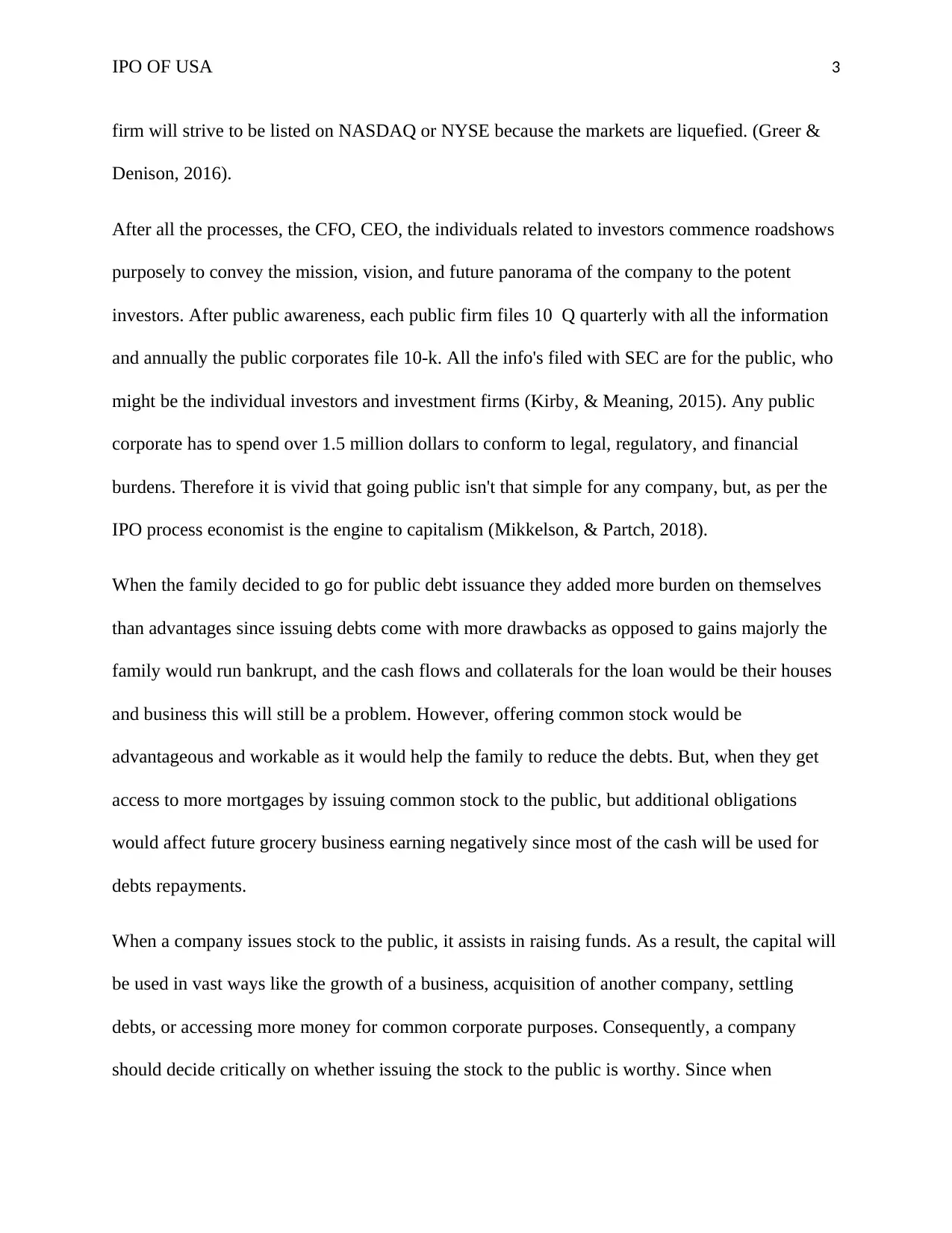
IPO OF USA 3
firm will strive to be listed on NASDAQ or NYSE because the markets are liquefied. (Greer &
Denison, 2016).
After all the processes, the CFO, CEO, the individuals related to investors commence roadshows
purposely to convey the mission, vision, and future panorama of the company to the potent
investors. After public awareness, each public firm files 10 Q quarterly with all the information
and annually the public corporates file 10-k. All the info's filed with SEC are for the public, who
might be the individual investors and investment firms (Kirby, & Meaning, 2015). Any public
corporate has to spend over 1.5 million dollars to conform to legal, regulatory, and financial
burdens. Therefore it is vivid that going public isn't that simple for any company, but, as per the
IPO process economist is the engine to capitalism (Mikkelson, & Partch, 2018).
When the family decided to go for public debt issuance they added more burden on themselves
than advantages since issuing debts come with more drawbacks as opposed to gains majorly the
family would run bankrupt, and the cash flows and collaterals for the loan would be their houses
and business this will still be a problem. However, offering common stock would be
advantageous and workable as it would help the family to reduce the debts. But, when they get
access to more mortgages by issuing common stock to the public, but additional obligations
would affect future grocery business earning negatively since most of the cash will be used for
debts repayments.
When a company issues stock to the public, it assists in raising funds. As a result, the capital will
be used in vast ways like the growth of a business, acquisition of another company, settling
debts, or accessing more money for common corporate purposes. Consequently, a company
should decide critically on whether issuing the stock to the public is worthy. Since when
firm will strive to be listed on NASDAQ or NYSE because the markets are liquefied. (Greer &
Denison, 2016).
After all the processes, the CFO, CEO, the individuals related to investors commence roadshows
purposely to convey the mission, vision, and future panorama of the company to the potent
investors. After public awareness, each public firm files 10 Q quarterly with all the information
and annually the public corporates file 10-k. All the info's filed with SEC are for the public, who
might be the individual investors and investment firms (Kirby, & Meaning, 2015). Any public
corporate has to spend over 1.5 million dollars to conform to legal, regulatory, and financial
burdens. Therefore it is vivid that going public isn't that simple for any company, but, as per the
IPO process economist is the engine to capitalism (Mikkelson, & Partch, 2018).
When the family decided to go for public debt issuance they added more burden on themselves
than advantages since issuing debts come with more drawbacks as opposed to gains majorly the
family would run bankrupt, and the cash flows and collaterals for the loan would be their houses
and business this will still be a problem. However, offering common stock would be
advantageous and workable as it would help the family to reduce the debts. But, when they get
access to more mortgages by issuing common stock to the public, but additional obligations
would affect future grocery business earning negatively since most of the cash will be used for
debts repayments.
When a company issues stock to the public, it assists in raising funds. As a result, the capital will
be used in vast ways like the growth of a business, acquisition of another company, settling
debts, or accessing more money for common corporate purposes. Consequently, a company
should decide critically on whether issuing the stock to the public is worthy. Since when
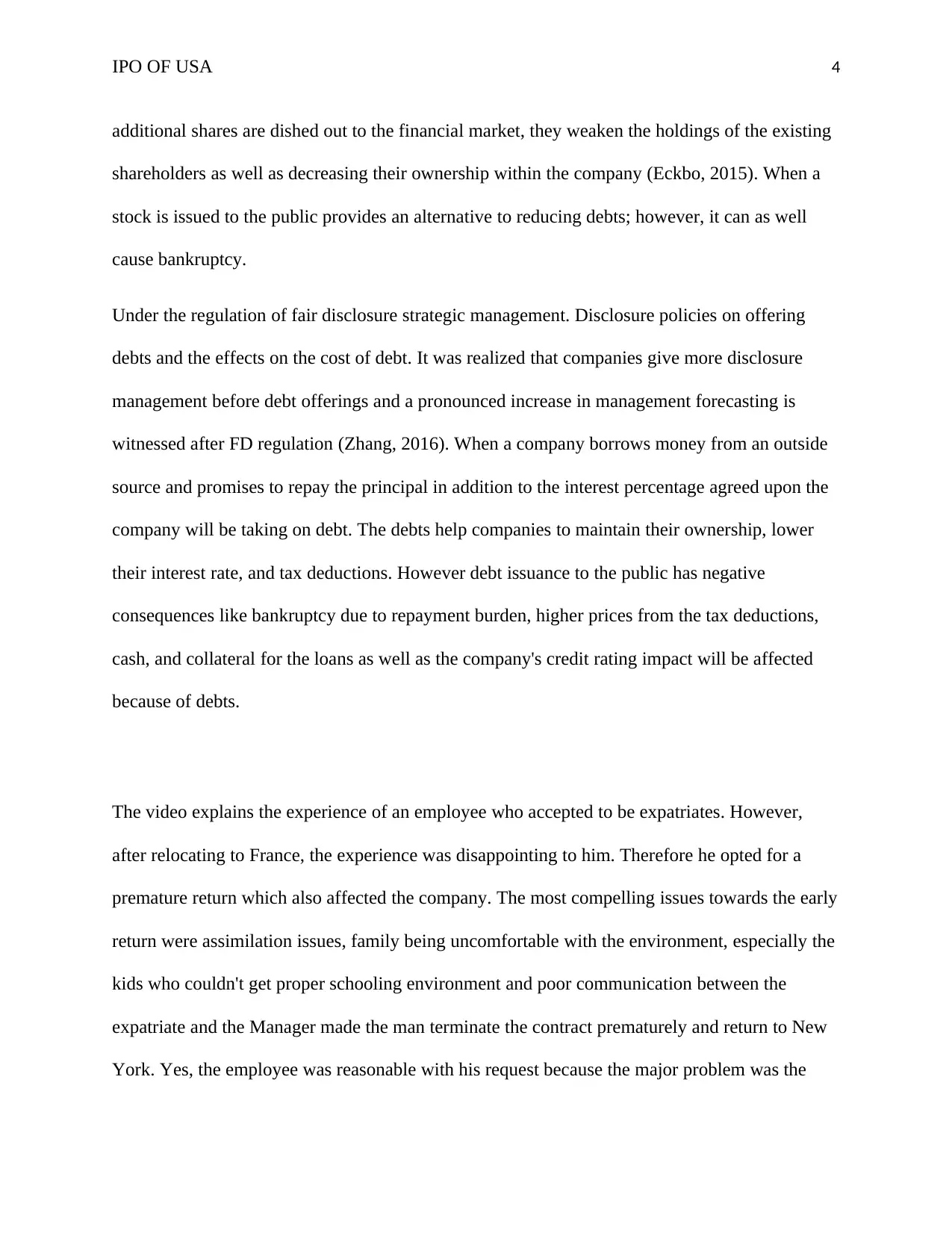
IPO OF USA 4
additional shares are dished out to the financial market, they weaken the holdings of the existing
shareholders as well as decreasing their ownership within the company (Eckbo, 2015). When a
stock is issued to the public provides an alternative to reducing debts; however, it can as well
cause bankruptcy.
Under the regulation of fair disclosure strategic management. Disclosure policies on offering
debts and the effects on the cost of debt. It was realized that companies give more disclosure
management before debt offerings and a pronounced increase in management forecasting is
witnessed after FD regulation (Zhang, 2016). When a company borrows money from an outside
source and promises to repay the principal in addition to the interest percentage agreed upon the
company will be taking on debt. The debts help companies to maintain their ownership, lower
their interest rate, and tax deductions. However debt issuance to the public has negative
consequences like bankruptcy due to repayment burden, higher prices from the tax deductions,
cash, and collateral for the loans as well as the company's credit rating impact will be affected
because of debts.
The video explains the experience of an employee who accepted to be expatriates. However,
after relocating to France, the experience was disappointing to him. Therefore he opted for a
premature return which also affected the company. The most compelling issues towards the early
return were assimilation issues, family being uncomfortable with the environment, especially the
kids who couldn't get proper schooling environment and poor communication between the
expatriate and the Manager made the man terminate the contract prematurely and return to New
York. Yes, the employee was reasonable with his request because the major problem was the
additional shares are dished out to the financial market, they weaken the holdings of the existing
shareholders as well as decreasing their ownership within the company (Eckbo, 2015). When a
stock is issued to the public provides an alternative to reducing debts; however, it can as well
cause bankruptcy.
Under the regulation of fair disclosure strategic management. Disclosure policies on offering
debts and the effects on the cost of debt. It was realized that companies give more disclosure
management before debt offerings and a pronounced increase in management forecasting is
witnessed after FD regulation (Zhang, 2016). When a company borrows money from an outside
source and promises to repay the principal in addition to the interest percentage agreed upon the
company will be taking on debt. The debts help companies to maintain their ownership, lower
their interest rate, and tax deductions. However debt issuance to the public has negative
consequences like bankruptcy due to repayment burden, higher prices from the tax deductions,
cash, and collateral for the loans as well as the company's credit rating impact will be affected
because of debts.
The video explains the experience of an employee who accepted to be expatriates. However,
after relocating to France, the experience was disappointing to him. Therefore he opted for a
premature return which also affected the company. The most compelling issues towards the early
return were assimilation issues, family being uncomfortable with the environment, especially the
kids who couldn't get proper schooling environment and poor communication between the
expatriate and the Manager made the man terminate the contract prematurely and return to New
York. Yes, the employee was reasonable with his request because the major problem was the
Secure Best Marks with AI Grader
Need help grading? Try our AI Grader for instant feedback on your assignments.
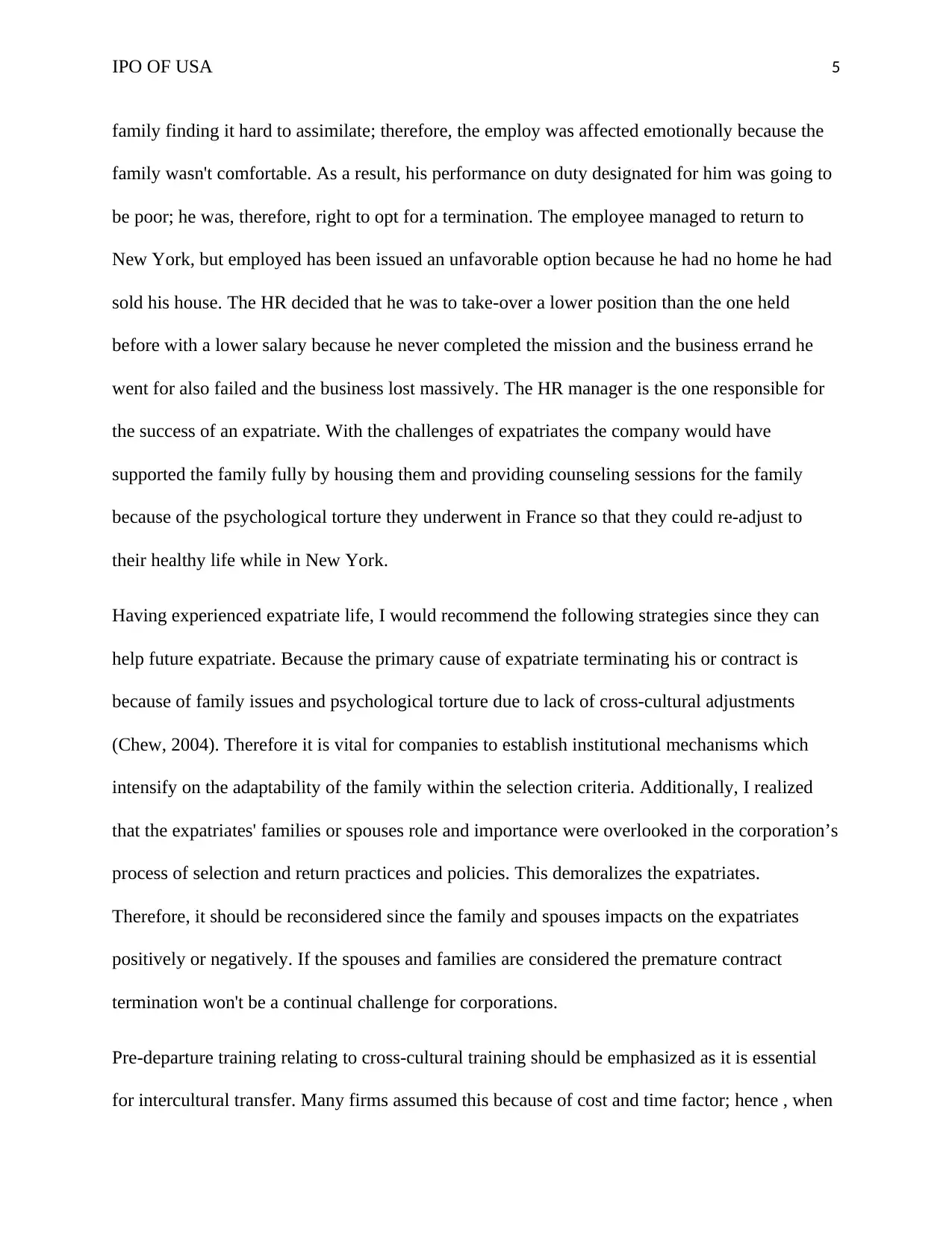
IPO OF USA 5
family finding it hard to assimilate; therefore, the employ was affected emotionally because the
family wasn't comfortable. As a result, his performance on duty designated for him was going to
be poor; he was, therefore, right to opt for a termination. The employee managed to return to
New York, but employed has been issued an unfavorable option because he had no home he had
sold his house. The HR decided that he was to take-over a lower position than the one held
before with a lower salary because he never completed the mission and the business errand he
went for also failed and the business lost massively. The HR manager is the one responsible for
the success of an expatriate. With the challenges of expatriates the company would have
supported the family fully by housing them and providing counseling sessions for the family
because of the psychological torture they underwent in France so that they could re-adjust to
their healthy life while in New York.
Having experienced expatriate life, I would recommend the following strategies since they can
help future expatriate. Because the primary cause of expatriate terminating his or contract is
because of family issues and psychological torture due to lack of cross-cultural adjustments
(Chew, 2004). Therefore it is vital for companies to establish institutional mechanisms which
intensify on the adaptability of the family within the selection criteria. Additionally, I realized
that the expatriates' families or spouses role and importance were overlooked in the corporation’s
process of selection and return practices and policies. This demoralizes the expatriates.
Therefore, it should be reconsidered since the family and spouses impacts on the expatriates
positively or negatively. If the spouses and families are considered the premature contract
termination won't be a continual challenge for corporations.
Pre-departure training relating to cross-cultural training should be emphasized as it is essential
for intercultural transfer. Many firms assumed this because of cost and time factor; hence , when
family finding it hard to assimilate; therefore, the employ was affected emotionally because the
family wasn't comfortable. As a result, his performance on duty designated for him was going to
be poor; he was, therefore, right to opt for a termination. The employee managed to return to
New York, but employed has been issued an unfavorable option because he had no home he had
sold his house. The HR decided that he was to take-over a lower position than the one held
before with a lower salary because he never completed the mission and the business errand he
went for also failed and the business lost massively. The HR manager is the one responsible for
the success of an expatriate. With the challenges of expatriates the company would have
supported the family fully by housing them and providing counseling sessions for the family
because of the psychological torture they underwent in France so that they could re-adjust to
their healthy life while in New York.
Having experienced expatriate life, I would recommend the following strategies since they can
help future expatriate. Because the primary cause of expatriate terminating his or contract is
because of family issues and psychological torture due to lack of cross-cultural adjustments
(Chew, 2004). Therefore it is vital for companies to establish institutional mechanisms which
intensify on the adaptability of the family within the selection criteria. Additionally, I realized
that the expatriates' families or spouses role and importance were overlooked in the corporation’s
process of selection and return practices and policies. This demoralizes the expatriates.
Therefore, it should be reconsidered since the family and spouses impacts on the expatriates
positively or negatively. If the spouses and families are considered the premature contract
termination won't be a continual challenge for corporations.
Pre-departure training relating to cross-cultural training should be emphasized as it is essential
for intercultural transfer. Many firms assumed this because of cost and time factor; hence , when
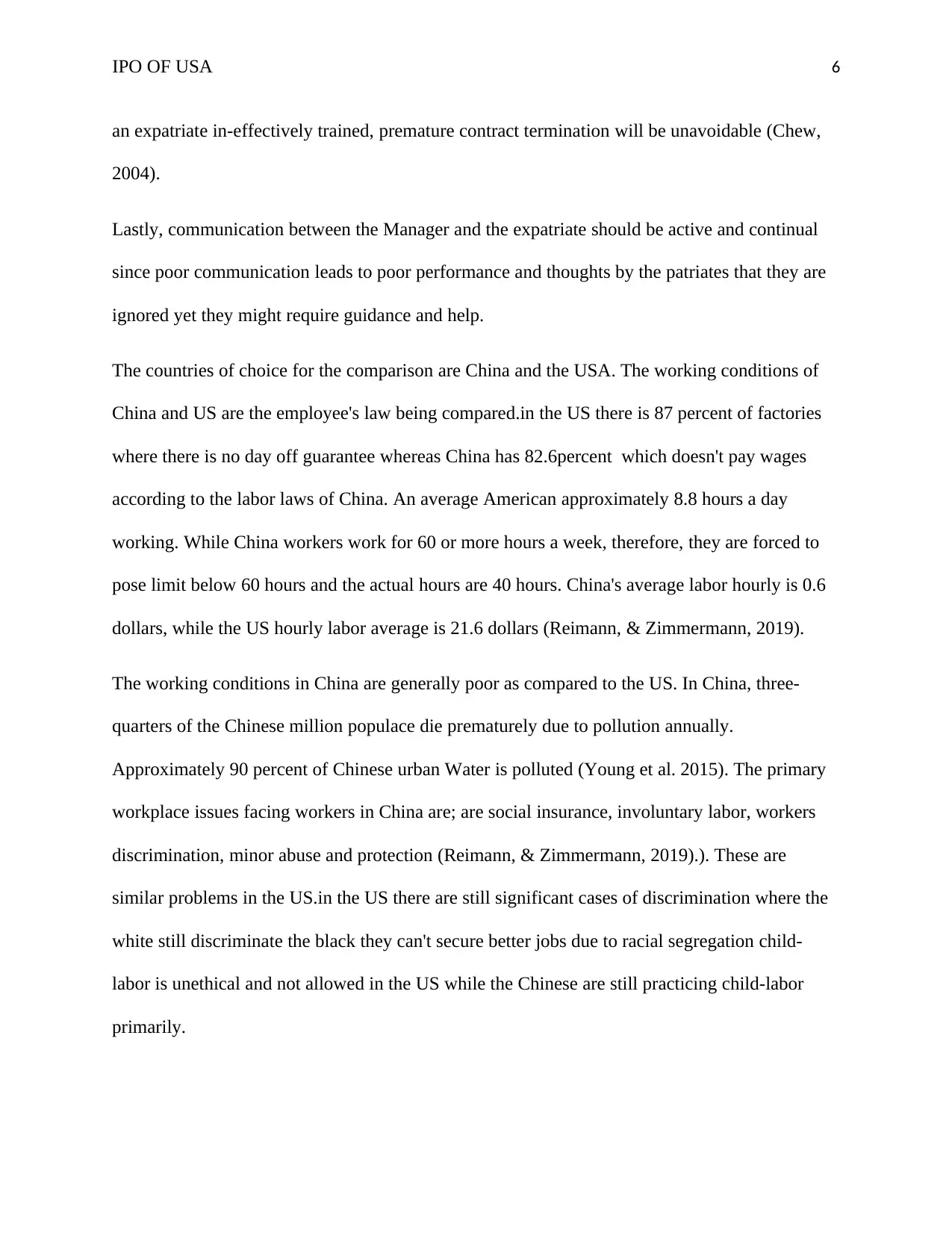
IPO OF USA 6
an expatriate in-effectively trained, premature contract termination will be unavoidable (Chew,
2004).
Lastly, communication between the Manager and the expatriate should be active and continual
since poor communication leads to poor performance and thoughts by the patriates that they are
ignored yet they might require guidance and help.
The countries of choice for the comparison are China and the USA. The working conditions of
China and US are the employee's law being compared.in the US there is 87 percent of factories
where there is no day off guarantee whereas China has 82.6percent which doesn't pay wages
according to the labor laws of China. An average American approximately 8.8 hours a day
working. While China workers work for 60 or more hours a week, therefore, they are forced to
pose limit below 60 hours and the actual hours are 40 hours. China's average labor hourly is 0.6
dollars, while the US hourly labor average is 21.6 dollars (Reimann, & Zimmermann, 2019).
The working conditions in China are generally poor as compared to the US. In China, three-
quarters of the Chinese million populace die prematurely due to pollution annually.
Approximately 90 percent of Chinese urban Water is polluted (Young et al. 2015). The primary
workplace issues facing workers in China are; are social insurance, involuntary labor, workers
discrimination, minor abuse and protection (Reimann, & Zimmermann, 2019).). These are
similar problems in the US.in the US there are still significant cases of discrimination where the
white still discriminate the black they can't secure better jobs due to racial segregation child-
labor is unethical and not allowed in the US while the Chinese are still practicing child-labor
primarily.
an expatriate in-effectively trained, premature contract termination will be unavoidable (Chew,
2004).
Lastly, communication between the Manager and the expatriate should be active and continual
since poor communication leads to poor performance and thoughts by the patriates that they are
ignored yet they might require guidance and help.
The countries of choice for the comparison are China and the USA. The working conditions of
China and US are the employee's law being compared.in the US there is 87 percent of factories
where there is no day off guarantee whereas China has 82.6percent which doesn't pay wages
according to the labor laws of China. An average American approximately 8.8 hours a day
working. While China workers work for 60 or more hours a week, therefore, they are forced to
pose limit below 60 hours and the actual hours are 40 hours. China's average labor hourly is 0.6
dollars, while the US hourly labor average is 21.6 dollars (Reimann, & Zimmermann, 2019).
The working conditions in China are generally poor as compared to the US. In China, three-
quarters of the Chinese million populace die prematurely due to pollution annually.
Approximately 90 percent of Chinese urban Water is polluted (Young et al. 2015). The primary
workplace issues facing workers in China are; are social insurance, involuntary labor, workers
discrimination, minor abuse and protection (Reimann, & Zimmermann, 2019).). These are
similar problems in the US.in the US there are still significant cases of discrimination where the
white still discriminate the black they can't secure better jobs due to racial segregation child-
labor is unethical and not allowed in the US while the Chinese are still practicing child-labor
primarily.
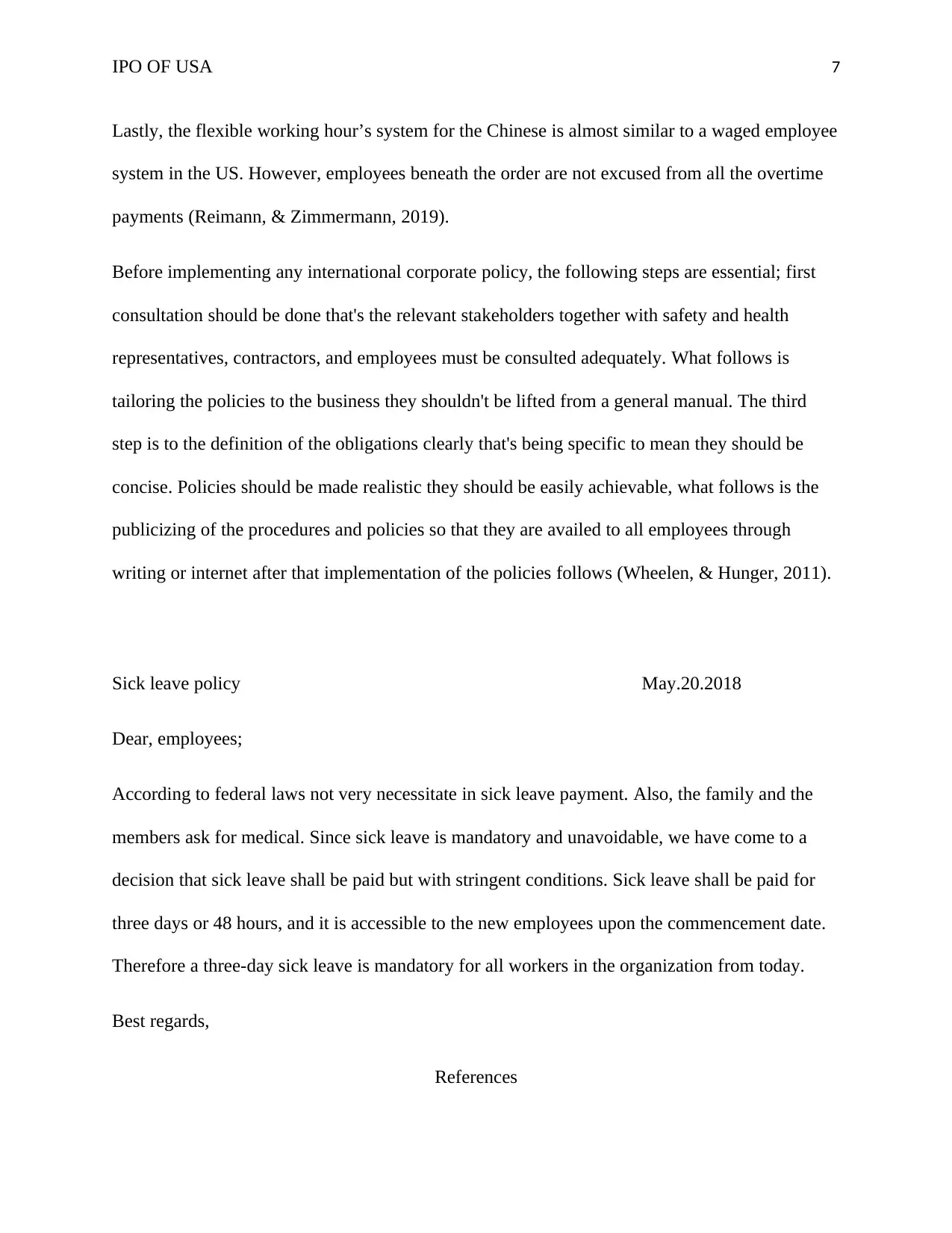
IPO OF USA 7
Lastly, the flexible working hour’s system for the Chinese is almost similar to a waged employee
system in the US. However, employees beneath the order are not excused from all the overtime
payments (Reimann, & Zimmermann, 2019).
Before implementing any international corporate policy, the following steps are essential; first
consultation should be done that's the relevant stakeholders together with safety and health
representatives, contractors, and employees must be consulted adequately. What follows is
tailoring the policies to the business they shouldn't be lifted from a general manual. The third
step is to the definition of the obligations clearly that's being specific to mean they should be
concise. Policies should be made realistic they should be easily achievable, what follows is the
publicizing of the procedures and policies so that they are availed to all employees through
writing or internet after that implementation of the policies follows (Wheelen, & Hunger, 2011).
Sick leave policy May.20.2018
Dear, employees;
According to federal laws not very necessitate in sick leave payment. Also, the family and the
members ask for medical. Since sick leave is mandatory and unavoidable, we have come to a
decision that sick leave shall be paid but with stringent conditions. Sick leave shall be paid for
three days or 48 hours, and it is accessible to the new employees upon the commencement date.
Therefore a three-day sick leave is mandatory for all workers in the organization from today.
Best regards,
References
Lastly, the flexible working hour’s system for the Chinese is almost similar to a waged employee
system in the US. However, employees beneath the order are not excused from all the overtime
payments (Reimann, & Zimmermann, 2019).
Before implementing any international corporate policy, the following steps are essential; first
consultation should be done that's the relevant stakeholders together with safety and health
representatives, contractors, and employees must be consulted adequately. What follows is
tailoring the policies to the business they shouldn't be lifted from a general manual. The third
step is to the definition of the obligations clearly that's being specific to mean they should be
concise. Policies should be made realistic they should be easily achievable, what follows is the
publicizing of the procedures and policies so that they are availed to all employees through
writing or internet after that implementation of the policies follows (Wheelen, & Hunger, 2011).
Sick leave policy May.20.2018
Dear, employees;
According to federal laws not very necessitate in sick leave payment. Also, the family and the
members ask for medical. Since sick leave is mandatory and unavoidable, we have come to a
decision that sick leave shall be paid but with stringent conditions. Sick leave shall be paid for
three days or 48 hours, and it is accessible to the new employees upon the commencement date.
Therefore a three-day sick leave is mandatory for all workers in the organization from today.
Best regards,
References
Paraphrase This Document
Need a fresh take? Get an instant paraphrase of this document with our AI Paraphraser
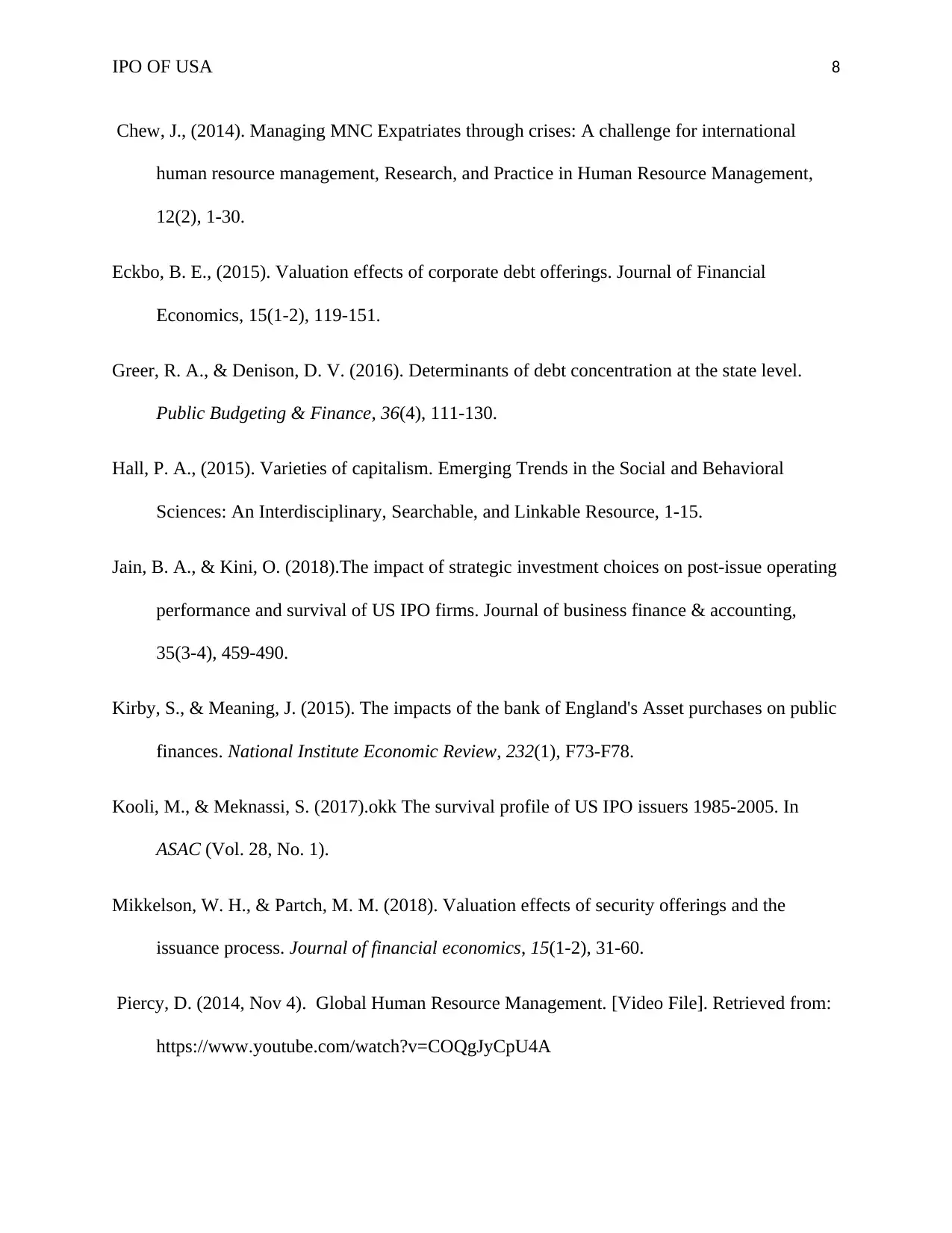
IPO OF USA 8
Chew, J., (2014). Managing MNC Expatriates through crises: A challenge for international
human resource management, Research, and Practice in Human Resource Management,
12(2), 1-30.
Eckbo, B. E., (2015). Valuation effects of corporate debt offerings. Journal of Financial
Economics, 15(1-2), 119-151.
Greer, R. A., & Denison, D. V. (2016). Determinants of debt concentration at the state level.
Public Budgeting & Finance, 36(4), 111-130.
Hall, P. A., (2015). Varieties of capitalism. Emerging Trends in the Social and Behavioral
Sciences: An Interdisciplinary, Searchable, and Linkable Resource, 1-15.
Jain, B. A., & Kini, O. (2018).The impact of strategic investment choices on post‐issue operating
performance and survival of US IPO firms. Journal of business finance & accounting,
35(3‐4), 459-490.
Kirby, S., & Meaning, J. (2015). The impacts of the bank of England's Asset purchases on public
finances. National Institute Economic Review, 232(1), F73-F78.
Kooli, M., & Meknassi, S. (2017).okk The survival profile of US IPO issuers 1985-2005. In
ASAC (Vol. 28, No. 1).
Mikkelson, W. H., & Partch, M. M. (2018). Valuation effects of security offerings and the
issuance process. Journal of financial economics, 15(1-2), 31-60.
Piercy, D. (2014, Nov 4). Global Human Resource Management. [Video File]. Retrieved from:
https://www.youtube.com/watch?v=COQgJyCpU4A
Chew, J., (2014). Managing MNC Expatriates through crises: A challenge for international
human resource management, Research, and Practice in Human Resource Management,
12(2), 1-30.
Eckbo, B. E., (2015). Valuation effects of corporate debt offerings. Journal of Financial
Economics, 15(1-2), 119-151.
Greer, R. A., & Denison, D. V. (2016). Determinants of debt concentration at the state level.
Public Budgeting & Finance, 36(4), 111-130.
Hall, P. A., (2015). Varieties of capitalism. Emerging Trends in the Social and Behavioral
Sciences: An Interdisciplinary, Searchable, and Linkable Resource, 1-15.
Jain, B. A., & Kini, O. (2018).The impact of strategic investment choices on post‐issue operating
performance and survival of US IPO firms. Journal of business finance & accounting,
35(3‐4), 459-490.
Kirby, S., & Meaning, J. (2015). The impacts of the bank of England's Asset purchases on public
finances. National Institute Economic Review, 232(1), F73-F78.
Kooli, M., & Meknassi, S. (2017).okk The survival profile of US IPO issuers 1985-2005. In
ASAC (Vol. 28, No. 1).
Mikkelson, W. H., & Partch, M. M. (2018). Valuation effects of security offerings and the
issuance process. Journal of financial economics, 15(1-2), 31-60.
Piercy, D. (2014, Nov 4). Global Human Resource Management. [Video File]. Retrieved from:
https://www.youtube.com/watch?v=COQgJyCpU4A
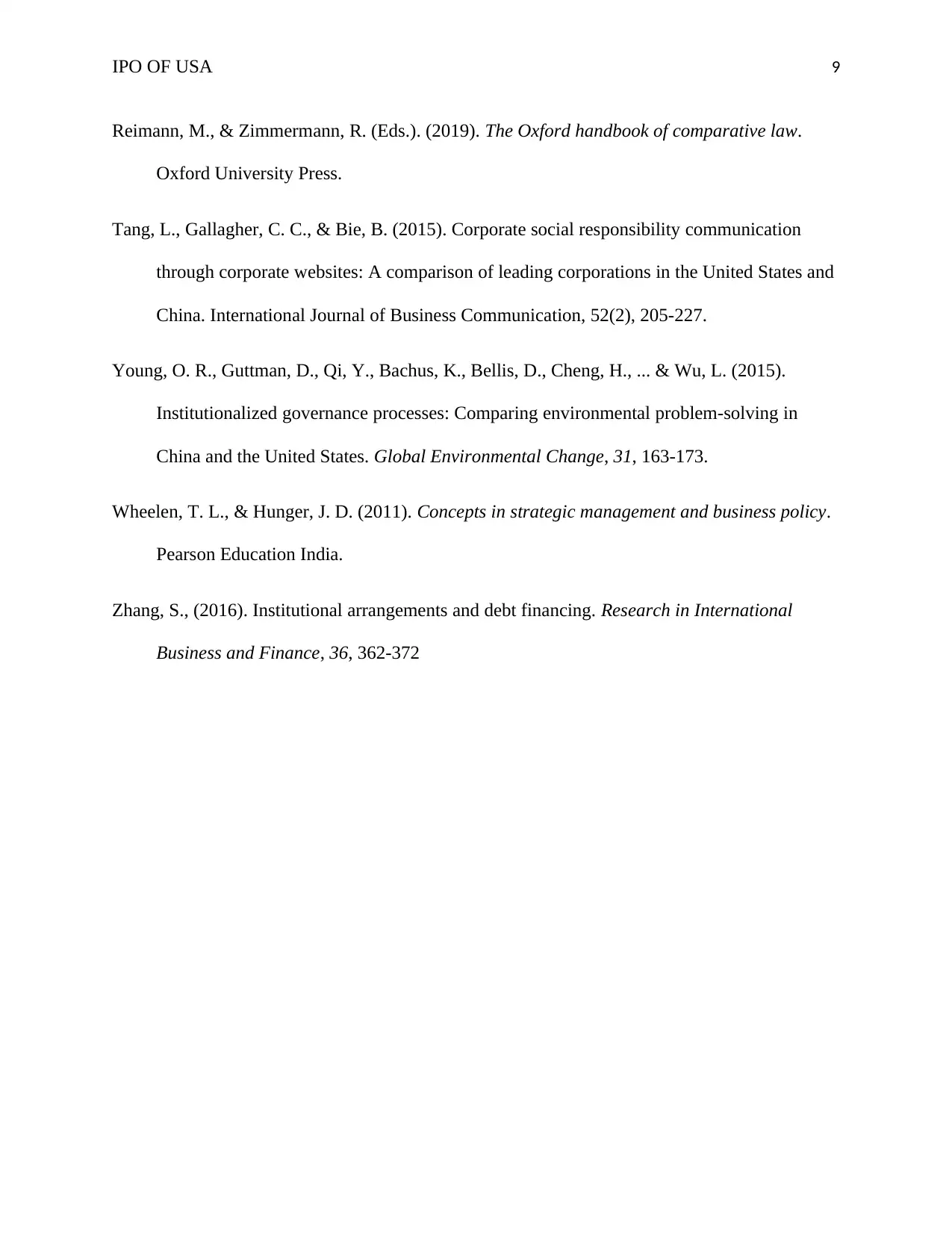
IPO OF USA 9
Reimann, M., & Zimmermann, R. (Eds.). (2019). The Oxford handbook of comparative law.
Oxford University Press.
Tang, L., Gallagher, C. C., & Bie, B. (2015). Corporate social responsibility communication
through corporate websites: A comparison of leading corporations in the United States and
China. International Journal of Business Communication, 52(2), 205-227.
Young, O. R., Guttman, D., Qi, Y., Bachus, K., Bellis, D., Cheng, H., ... & Wu, L. (2015).
Institutionalized governance processes: Comparing environmental problem-solving in
China and the United States. Global Environmental Change, 31, 163-173.
Wheelen, T. L., & Hunger, J. D. (2011). Concepts in strategic management and business policy.
Pearson Education India.
Zhang, S., (2016). Institutional arrangements and debt financing. Research in International
Business and Finance, 36, 362-372
Reimann, M., & Zimmermann, R. (Eds.). (2019). The Oxford handbook of comparative law.
Oxford University Press.
Tang, L., Gallagher, C. C., & Bie, B. (2015). Corporate social responsibility communication
through corporate websites: A comparison of leading corporations in the United States and
China. International Journal of Business Communication, 52(2), 205-227.
Young, O. R., Guttman, D., Qi, Y., Bachus, K., Bellis, D., Cheng, H., ... & Wu, L. (2015).
Institutionalized governance processes: Comparing environmental problem-solving in
China and the United States. Global Environmental Change, 31, 163-173.
Wheelen, T. L., & Hunger, J. D. (2011). Concepts in strategic management and business policy.
Pearson Education India.
Zhang, S., (2016). Institutional arrangements and debt financing. Research in International
Business and Finance, 36, 362-372

IPO OF USA 10
1 out of 10
Related Documents
Your All-in-One AI-Powered Toolkit for Academic Success.
+13062052269
info@desklib.com
Available 24*7 on WhatsApp / Email
![[object Object]](/_next/static/media/star-bottom.7253800d.svg)
Unlock your academic potential
© 2024 | Zucol Services PVT LTD | All rights reserved.





